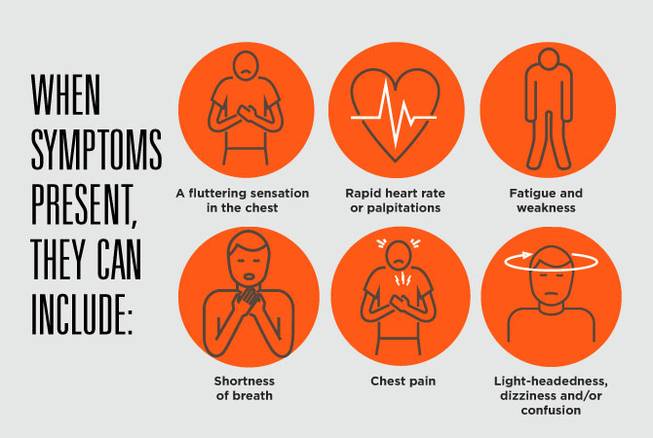
Monday, Jan. 23, 2017 | 2 a.m.
Atrial fibrillation, also referred to as AF or A-fib, is the most common type of irregular heartbeat, or heart arrhythmia. The American Heart Association reports that there are 2.7 million Americans living with AF, though that number could be much higher, as people can have the condition unknowingly.
“AF might not be bad on its own, but it keeps bad company. Many people tend not to realize that AF is one of the largest risk factors for major strokes, and it can cause congestive heart failure and other cardiac diseases,” said Gaston Vergara, MD, cardiologist at Sunrise Hospital and Medical Center.
Understanding, recognizing and taking proactive measures against AF can potentially save your life.
What is atrial fibrillation?
Atrial fibrillation is a heart disease that causes an irregular heartbeat and often a higher heart rate. While the causes of AF are unknown, it’s closely linked to many other cardiac diseases such as high blood pressure, heart valve disorders, coronary artery disease and heart failure.
AF can present in tandem with other cardiac conditions, or it can present as a precursor to other associated diseases.
Symptoms
Part of what makes atrial fibrillation so dangerous is that many people with the disease may experience mild, negligible symptoms, or even none at all. Older patients, especially those with other conditions and higher risk factors, usually fall in this category. “Unfortunately, some patients don’t have any symptoms until they have a sudden stroke,” Vergara said. He also said that even in the absence of these symptoms, some patients may just feel as though “something is off.” While AF is less common in young, healthy people, they often have more noticeable symptoms.
When symptoms do present, they can include:
• A fluttering sensation in chest
• Rapid heart rate or palpitations
• Fatigue and weakness
• Shortness of breath
• Chest pain
• Light-headedness, dizziness and/or confusion
Risk factors
As with many heart diseases, the risk for atrial fibrillation increases with age, and usually presents in patients over age 50. “Further, the general population of people over 80 will likely have AF,” Vergara said. Genetics, other cardiac diseases, diabetes, obesity, smoking, sleep apnea, lung disorders, hormonal disorders and excessive alcohol consumption are all potential risk factors as well.
Atrial fibrillation can cause strokes
AF is the second-leading cause of strokes in the U.S. and the American Heart Association reports that 15-20 percent of all stroke patients have this heart condition. The Harvard Medical School reports that AF increases the risk of stroke fivefold and doubles the risk of premature death.
“The stroke risk associated with AF is very serious. Not only do we know that AF causes stroke, sometimes without any other risk factors or warning signs, the strokes associated with AF tend to be especially debilitating. This is because AF can cause multiple blood clots to reach the brain at once, damaging different control centers throughout the brain,” Vergara said. Because the risk of stroke is so high for AF patients, it’s important that people recognize the danger in this common disease. People over the age of 55 and/or with qualifying risk factors need to talk with their doctor about AF and be screened for the disease regularly.
How is AF diagnosed and treated?
Diagnosing AF is usually a fairly simple process that includes a doctor’s exam and an electrocardiogram (EKG). If AF is detected, your doctor may want to do follow-up tests and blood work to ensure there are no other underlying diseases such as high blood pressure.
While AF cannot be completely cured, there are many ways to treat and manage the disease. “Once AF is found, it will continue to be monitored throughout the patient’s lifetime. Typically, the problem needs to be tackled from two sides: one is to immediately limit the chances of a stroke by preventing blood clots. The other is dealing with the AF itself, which is to relieve any symptoms and/or stop the development of other associated diseases,” Vergara said.
Blood-thinning medication is a common treatment method for preventing blood clots caused by AF. There also is medication available to help slow, control and regulate the heart rate. Beyond medicine, there are treatments that may be used to restore the patient’s normal heart rhythm. This can be done using a low-voltage electrical shock or by surgically implanting catheters into the heart valves, which usually can be done using minimally invasive techniques. Depending on the patient’s medical history, AF treatment may require one or a combination of different methods. “We have many more tools to treat AF than ever before,” Vergara said.

Join the Discussion:
Check this out for a full explanation of our conversion to the LiveFyre commenting system and instructions on how to sign up for an account.
Full comments policy